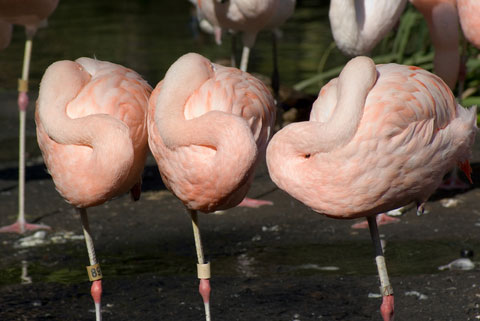Why Flamingos Stand on One Leg

The brilliant pink feathers, gangly neck and upside-down eating are enough to make flamingos a spectacle at any zoo and generate a barrage of questions from curious children. But one stumper for scientists has always been: Why do flamingos stand on one leg?
Flamingos (Phoenicopterus rubber) are known to often stand on one leg while resting. Scientists have put forward a number of ideas as to why the birds favor this unipedal stance while taking a snooze, but none had ever tested out their explanations.
Enter Matthew Anderson, a psychologist at Saint Joseph's University in Philadelphia. Anderson had studied various behaviors of flamingos, including why they tend to prefer bending their neck to the right and not the left when they lay it on their backs to sleep. The next logical step in his research was to see if they had a preference for their right or left foot while standing and resting. It was then that Anderson noticed that no one had even tested why flamingos favor standing on one foot over two.
Untested ideas
Among the untested ideas put forward by scientists for the one-legged posture were that it helped reduce muscle fatigue and that it was important to thermoregulation, or the maintenance of body temperature, Anderson said.
The rationale behind the muscle fatigue theory: Standing on one leg would prevent both leg muscles from stiffening and tiring out, so that if a predator came along, the flamingo would be able to get moving faster.
Thermoregulation was offered as a reason for the flamingos' unusual posture because it was known that legs and feet were a significant source of heat loss in birds, and keeping one leg up close to the body would conserve heat.
Get the world’s most fascinating discoveries delivered straight to your inbox.
To test these ideas, Anderson and his team observed a captive flock at the Philadelphia Zoo.
To evaluate the muscle fatigue theory, the researchers watched the flamingos and timed how long it took for them to start moving from both unipedal and bipedal resiting positions. If the theory was correct, the birds should take their first steps faster coming from the unipedal position, but Anderson found that the birds were faster off the block when they had been standing on both legs, ruling out that theory.
To put the idea of thermoregulation to the test, the team noted the temperature and weather conditions when the flamingos were resting. They found that when it was warmer, more birds would stand on two feet, while in cooler weather, more favored the one-legged stance. (Overall though, the majority of the flock favored standing on one leg.)
Water dwellers
The idea that a bird that lives in tropical climates would need to hold in its body heat may seem counter-intuitive, but flamingos spend most of their time in the water, and water causes them to lose body heat more rapidly — just think about the shiver that comes after getting out of a pool, even on a hot summer day.
"The water just pulls away the body heat really, really quickly," Anderson told LiveScience. "So [the flamingo] really needs as much heat saving as it can possibly get."
While more research needs to be done, particularly in observing wild flocks of flamingoes, Anderson said his work, to be detailed in an upcoming issue of the journal Zoo Biology, shows that thermoregulation is a key reason behind the iconic flamingo stance. Though it doesn't rule out other benefits of the posture, such as minimizing contact with parasites and fungi that might be present in the water they are wading in.
- Video – Extraordinary Birds
- Bird News, Images and Information
- Flamingos Get a Rise From Eating

Andrea Thompson is an associate editor at Scientific American, where she covers sustainability, energy and the environment. Prior to that, she was a senior writer covering climate science at Climate Central and a reporter and editor at Live Science, where she primarily covered Earth science and the environment. She holds a graduate degree in science health and environmental reporting from New York University, as well as a bachelor of science and and masters of science in atmospheric chemistry from the Georgia Institute of Technology.


